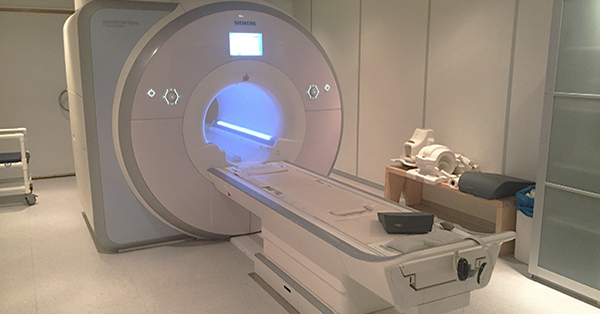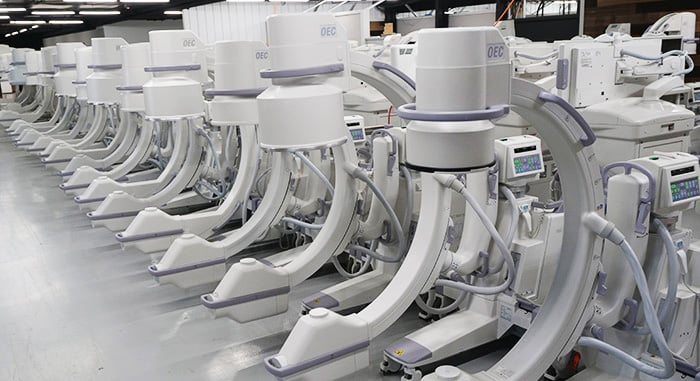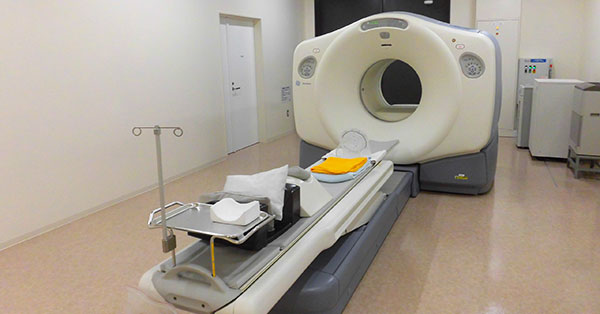
Information on the differences between 1.5T and 3T MRIs can be difficult to find. Our buyers often ask us, "When should you choose a 3T over a 1.5T MRI?" or, "does the basic math of 1.5 + 1.5 = 3 mean that a 3T MRI is twice as good as a 1.5T MRI?" We will answer all these questions and more through the course of this comparison guide.
- What’s the Difference Between a 1.5T and 3T MRI?
- 1.5T MRI Machines Are Still Standard
- Machine Speed and Your Needs
- Supply and Demand
- MRI Suite Needs
- 1.5T vs 3T MRI Question Checklist
Note: Block Imaging is dedicated to provide new and refurbished MRI machines and parts in order to solve all the pain points listed above. You can read about it in detail below or reach out to our sales team to learn more about how it can help improve diagnostic imaging.
What’s the difference between a 1.5T and 3T MRI?
The main difference between a 1.5T and a 3T MRI machine is the magnetic strength. MRI systems are basically giant electromagnets. The “T” in 1.5T and 3T stands for “Tesla,” a unit to measure Magnetic Field Strength (MFS). The 1.5T operates at about 15,000 Gauss, which is about 30,000 times the earth’s magnetic field, but don’t worry, the patient in the MRI does not feel that weight.
Typically, both 1.5T and 3T MRIs come in wide bore and closed bore options. The open bore MRIs are generally made with a weaker magnet like a .2T, .3T, .7T, or even a 1.0T. However, it’s helpful to look at the model features to find how and why that difference matters and what questions to ask yourself when looking to buy an MRI.
1.5T Features
The 1.5T scanner is the quintessential MRI machine. It's powerful enough to perform the vast majority of common MRI studies, readily available on the secondary market, and (relatively speaking) moderately priced.
Best used for general imaging, cardiac extremities, and cardiac imaging, the 1.5T is often the go-to MRI because of its versatile use cases. Because of this, many doctors prefer this magnet strength in a model.
Most 1.5T MRIs will come in a wide bore or closed bore set up and will have the following components that will affect your process of searching for the right one to buy:
- Channel coils: Typically, MRI coils simply name the body part they image, such as head coil, spine coil, breast coil, etc. These coils combined make a channel system and 1.5T MRIs can come in 4, 8, 16, or 32-channel systems
- Software levels: We hear from 1.5T MRI users who prefer the idea of keeping their current magnet and upgrading its electronics and software, which typically quicken scan times and increase capabilities for different types of imaging.
- Gradient types: Gradients are actually smaller magnets inside the main MRI magnet. Their job is to modify the magnetic field in the area being scanned so the system can “listen” for the resonance and create an image.
Block Imaging’s Top Selling 1.5T MRIs of 2023
Take a look at our Siemens models comparisons and our GE models comparisons for a closer examination of the differences within each brand.
- Siemens 1.5T Avanto MRI
- GE 1.5T EXCITE HDXt MRI
- Siemens 1.5T Essenza MRI
- Siemens 1.5T Espree MRI
- GE 1.5T SIGNA Explorer MRI
- Philips 1.5T Achieva MRI
- GE 1.5T Optima 450W MRI
3T Features
The components of the 1.5T MRI are largely the same as the 3T MRI, with channel coils, software, and gradient type. However, the 3T MRI uses the magnetic strength of 3 teslas, which is twice the amount of strength of a 1.5T MRI. The strength of these magnetic fields are directly correlated to image quality, which is why these systems are used to make images of the brain, spine, soft joint tissue, and the insides of bones and blood vessels.
The only way a 1.5T MRI can reduce image noise is through using multi-channel phased array coils from the other end with more coil elements closer to the anatomy being studied. The trade-off is in the time spent. In comparison, the 3T MRI still outpaces getting clear images of small or intricate studies like vascular, brain, or prostate exams quickly.
Additionally, 3T MRIs are often bigger in size - which means a system may need a bigger room or suite. It also means that the bore opening itself might be bigger, lending itself to a less claustrophobic experience for many patients.
When wanting to provide top-quality imaging or as a way to be competitive, many doctors will opt for the investment into a 3.0T MRI.
Block Imaging’s Top Selling 3T MRIs
At the top of the list is the Siemens 3.0T Veri MRI, which is among the best scanners ever made. Since they are often a rarity on the secondary market, we often recommend the 3.0T Trio TIM MRI as a viable alternative solution. Check out our comparison between these two models here.
- Siemens 3.0T Verio MRI
- GE 3T Discovery MR750 MRI
- GE 3.0T EXCITE HDXt MRI
- Siemens Prisma FIT 3.0T MRI
- Siemens 3.0T Trio TIM MRI
- Siemens 3.0T Skyra MRI
1.5T MRI Machines Are Still Standard
Even with 3T technology available, a 1.5T MRI is completely adequate for most MRI scans that are done today. The 1.5T short-bore MRI remains the standard and accounts for the vast majority of scanners currently in use.
It’s not that 3Ts haven’t “caught on", but considering the climate of consolidation, reimbursement changes, patient needs, and competition, it's necessary to be deliberate about equipment choices, especially when weighed against facility improvements, staffing, and needs coming from other modalities.
Though the price tag to acquire a 3T is substantially higher than a 1.5T, the federal reimbursement is the same for both.
MRI Machine Speed and your Imaging Needs?
MRI studies are a compromise between scan time and image quality. Faster scans aren't as clear as longer ones, but longer ones can make your MRI suite a bottleneck for your facility. Many MRI buyers seek a 3T scanner as a balanced remedy for this dilemma: better image clarity at comparable scan times to a 1.5T, or a slight sacrifice in clarity for significant time savings.
You can still get beautiful images with a 1.5T system using multi-channel phased array coils, but scan times are longer than a 3T. Conversely, you can shorten scan times with a 1.5T system too, but the image quality sacrifice will be more than on a 3T. It all depends upon the type of study that’s needed - both will get you where you need to go, but before you buy one or the other, it’s important to assess how quickly you actually need to get there.
Supply and Demand
If you’re doing studies that involve very minute detail, or if your market area, volume, or referring doctors are leaning you toward 3T, then be sure to plan ahead. 3T is costly. Even on the secondary market the price tag could easily be double what you’d pay for a 1.5T.
Give yourself time to locate a 3T. Availability has increased, but they're still not as common as their 1.5T counterparts.
Make sure your room can accommodate a 3T. Typically, the active shielding on these magnets is good enough to contain the five-gauss line in a moderately sized room, but some testing is in order to make sure. Keep in mind: the strength of magnets used to pick up cars in junkyards is about the same as a 1.5T MRI. 3Ts have twice as much magnetic field. Be sure your safety measures are sufficient!
MRI Suite Needs
One of the questions you should ask when determining if you need a 1.5T or 3T is: “How big of a room do I need for my MRI suite?” The rooms in the MRI suite include:
- Scan Room: This room is where the magnet and the table are. It's where patients are scanned, hence the name.
- Equipment Room: This space holds the cabinets of electronic equipment that connect to the magnet.
- Control Room: The tech works from this room during a scan. It holds a desk, chair, and computer workstation.
- Changing Room: This room is not required, but it's very common for facilities to add a small changing room for patients. This improves their experience and can also be a helpful place for you to store your QA phantoms, manuals, or other system accessories.
MRI Suite Dimensions
If you're building an MRI suite at your facility from the ground up, it is important to not only consider space for the MRI suite itself, but also for things like waiting areas, hallways, offices, etc. In this case, the space needed to start is around 800-850 square feet.
If you're adding an MRI suite to an existing facility with offices, hallways, and waiting areas already in place the space you'll need to reallocate or add on is around 650 square feet.
MRI Building Costs
The obvious follow up question to space is price, right? Although there are variables at play between location, materials, suppliers, and builders, a good benchmark for new construction is $400 per square foot.
- What kind of images will I need my MRI for?
- What is my timetable and price range?
- Does patient throughput factor into my decision?
- How big of a room do I need for my MRI suite?
Conclusion
If your studies are less detailed or your pace is less hectic, you’ll be able to get everything you need from a 1.5T system equipped with multi-channel coils. These systems are more readily available, as are replacement parts and service engineers to keep them running.
If your work will be of the most delicate nature, or if your patient volume is particularly high, the crisper image clarity and potential time savings of a 3T system could be worth investing in.


Steve Rentz
Steve Rentz is the Product Manager for MRI Scanners at Block Imaging. Steve's goal is to earn each customer's trust and business by specifically addressing the needs of their unique project. When Steve is not helping customers with their MRI needs, he enjoys running, swimming, and woodworking.





